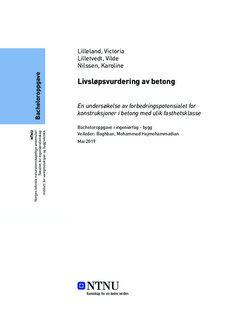| dc.contributor.advisor | Baghban, Mohammad Hajmohammadian | |
| dc.contributor.advisor | Huang, Lizhen | |
| dc.contributor.author | Lilleland, Victroia | |
| dc.contributor.author | Lilletvedt, Vilde | |
| dc.contributor.author | Nilssen, Karoline | |
| dc.date.accessioned | 2019-09-06T14:02:26Z | |
| dc.date.available | 2019-09-06T14:02:26Z | |
| dc.date.issued | 2019 | |
| dc.identifier.uri | http://hdl.handle.net/11250/2613163 | |
| dc.description.abstract | Hensikten med bacheloroppgaven er å undersøke om fasthetsklasser og spennvidde spiller inn på miljøutslippet til en betongkonstruksjon. Oppdragsgiver er Con-Form Oslo AS, og formålet med undersøkelsen er å gi de en indikasjon på om valg av betong med høyere fasthet vil gi mindre miljøavtrykk.
Metoden som er benyttet til å belyse problemstillingen er en kombinasjon av egendimensjonerte konstruksjoner, gjennomføring av livsløpsvurderinger (LCA) og en litteraturstudie. Resultatene fra vurderingen ble brukt til å se på forskjellen i miljøavtrykket til de ulike betongfasthetsklassene B30 og B90 for spennvidder på 4 m og 8 m.
Resultatene viste at B90 har mindre miljøutslipp enn B30 i 10 av de 12 tilfellene som ble vurdert. I konstruksjonen med det største spennet kommer B90 best ut i alle tilfellene, men i det minste spennet er B30 best i 2 av 6 tilfeller. På bakgrunn av dette, konkluderes det med at ved økende spennvidde gir B90 mindre utslipp enn B30. Videre ble det undersøkt om betong med høy andel flyveaske vil gi en positiv utvikling på miljøutslippene sammenliknet med B30 og B90. Undersøkelsen viste at denne betongen er et mer miljøvennlig valg i alle tilfeller. I sammenlikning med massivtre er også denne betongsammensetningen mer miljøvennlig i noen av tilfellene. | |
| dc.description.abstract | This bachelor thesis aims to investigate whether compressive strength and span length play a part in the environmental emissions of a concrete construction. The employer is Con-Form Oslo AS, and the purpose of the study is to give them an indication of whether the choice of concrete with higher strength will give less environmental footprint.
The method, used in the thesis, is a combination of self-dimensioned constructions, implementation of life cycle assessments (LCA) and a literature study. The results of the assessment were used to see the difference in the environmental impact of the various compressive strength classifications, C30 and C90 with different lengths of span.
Based on the findings, the C90 shows less environmental emissions than C30 in 10 of the 12 considered cases. In the construction with the largest span length C90 show the best result in all the cases, but for the other construction C30 is the best choice in 2 of 6 cases. From these results it is concluded that with the increasing span length, C90 produces less emissions than C30. Furthermore, it was examined whether concrete with a high proportion of fly ash will give a positive development of the environmental emissions compared to C30 and C90. The study showed that this concrete is a more environmentally friendly choice in all the considered cases. In comparison to CLT (solid wood), the concrete with a high proportion of fly ash is also environmentally friendly in some of the cases. | |
| dc.language | nob | |
| dc.publisher | NTNU | |
| dc.title | Livsløpsvurdering av betong En undersøkelse av forbedringspotensialet for konstruksjoner i betong med ulik fasthetsklasse | |
| dc.type | Bachelor thesis | |
